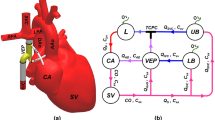Abstract
A blood pump specifically designed to augment flow from the great veins through the lungs would ameliorate the poor physiology of the failing univentricular circulation and result in a paradigm shift in the treatment strategy for Fontan patients. This study is the first to examine mechanical cavopulmonary assistance with a blood pump in the inferior vena cava (IVC) and hepatic blood flow. Five numerical models of mechanical cavopulmonary assistance were investigated using a three-dimensional, reconstructed, patient-specific Fontan circulation from magnetic resonance imaging data. Pressure flow characteristics of the axial blood pump, energy augmentation calculations for the cavopulmonary circulation with and without pump support, and hemolysis estimations were determined. In all of the pump-supported scenarios, a pressure increase of 7–9.5 mm Hg was achieved. The fluid power of the cavopulmonary circulation was also positive over the range of flow rates. No retrograde flow from the IVC into the hepatic circulation was evident during support cases. Vessel suction risk, however, was found for greater operating rotational speeds. Fluid shear stresses and hemolysis predictions remained at acceptable levels with normalized index of hemolysis estimations at 0.0001 g/100L. The findings of this study support the continued design and development of this blood pump technology for Fontan patients with progressive cardiovascular insufficiency. Validation of these flow and performance predictions will be completed in the next round of experimental testing with blood bag evaluation.









Similar content being viewed by others
References
Bludszuweit C (1995) Three-dimensional numerical prediction of stress loading of blood particles in a centrifugal pump. Artif Organs 19:590–596
Calbet JA, Jensen-Urstad M, van Hall G, Holmberg HC, Roshdahl H, Saltin B (2004) Maximal muscular vascular conductances during whole body upright exercise in humans. J Physiol 558:319–331
Chopski SG, Downs EA, Haggerty CM, Yoganathan AP, Throckmorton AL (2011) Laser flow measurements of an idealized total cavopulmonary connection with mechanical circulatory assistance. Artif Organs 35(11):1052–1064
de Leval MR, Deanfield JE (2010) Four decades of Fontan palliation. Nat Rev Cardiol 7:520–527
Downs EA, Moskowitz WB, Throckmorton AL (2012) Intravascular mechanical cavopulmonary assistance of 3-D patient-specific Fontan configurations. Artif Organs 36(11):972–980
He Y, Liu H, Himeno R (2004) A one-dimensional thermo-fluid model of blood circulation in the human upper limb. Int J Heat Mass Transfer 47:2735–2745
Koller T, Hawrylenko A (1967) Contribution to the in vitro testing of pumps for extracorporeal circulation. J Thorac Cardiovasc Surg 54:22–29
Lamour JM, Kanter KR, Naftel DC, Chrisant MR, Morrow WR, Clemson BS et al (2009) The effect of age, diagnosis, and previous surgery in children and adults undergoing heart transplantation for congenital heart disease. J Am Coll Cardiol 54(2):160–165
Mitamura Y, Nakamura H, Sekine K (2000) Prediction of hemolysis in rotary blood pumps with computational fluid dynamics analysis. J Circ Support 1(1):1–6
Nosé Y (1998) Design and development strategy for the rotary blood pump. Artif Organs 22(6):438–446
Paul R, Apel J, Klaus S, Schugner F, Schwindke P, Reul H (2003) Shear stress related blood damage in laminar couette flow. Artif Organs 27(6):517–529
Pennati G, Migliavacca F, Dubini G, Pietrabissa R, Fumero R, de Leval MR (2000) Use of mathematical model to predict hemodynamics in cavopulmonary anastomosis with persistent forward flow. J Surg Res 89:43–52
Piran S, Veldtman G, Siu S, Webb GD, Liu PP (2002) Heart failure and ventricular dysfunction in patients with single or systemic right ventricles. Circulation 105:1189–1194
Rychik J, Spray TL (2002) Strategies to treat protein-losing enteropathy. Semin Thorac Cardiovasc Surg Pediatr Card Surg Annu 5:3–11
Ryu K, Healy TM, Ensley AE, Sharma S, Lucas C, Yoganathan AP (2001) Importance of accurate geometry in the study of the total cavopulmonary connection: computational simulations and in vitro experiments. Ann Biomed Eng 29:844–853
Shenberger JS, Prophet SA, Waldhausen JA, Davidson WR, Sinoway LI (1989) Left subclavian flap aortoplasty for coarctation of the aorta: effects on forearm vascular function and growth. J Am Coll Cardiol 14:953–959
Song X, Throckmorton AL, Wood HG, Antaki JF, Olsen DB (2004) Quantitative evaluation of blood damage in a centrifugal VAD by computational fluid dynamics. J Fluids Eng 126:410–418
Throckmorton AL, Chopski SG (2008) Pediatric circulatory support systems: current strategies and future directions. biventricular and univentricular mechanical assistance. ASAIO J 54:491–497
Throckmorton AL, Carr JP, Tahir SA, Tate R, Downs EA, Bhavsar SS et al (2011) Mechanical cavopulmonary assistance of a patient-specific Fontan physiology: numerical simulations, lumped parameter modeling, and suction experiments. Artif Organs 35(11):1036–1047
Throckmorton AL, Kapadia JY, Chopski SG, Bhavsar SS, Moskowitz WB, Gullquist SD et al (2011) Mechanical cavopulmonary assist using an intravascular axial flow blood pump. Ann Biomed Eng 39(1):324–336
Throckmorton AL, Downs EA, Hazelwood JA, Monroe JO, Chopski SG (2012) Twisted cardiovascular cages for intravascular axial flow blood pumps to support the Fontan physiology. Int J Artif Organs 35(5):360–368
Van Nieuwenhuizen RC, Peters M, Lubbers LJ, Trip MD, Tijssen JG, Mulder BJ (1999) Abnormalities in liver function and coagulation profile following the Fontan procedure. Heart 82:40–46
Wang R, Lacour-Gayet FG, Lanning CJ, Rech BA, Kilfoil PJ, Hertzberg J et al (2006) Initial experience with the development and numerical and in vitro studies of a novel low-pressure artificial right ventricle for pediatric Fontan patients. ASAIO J 52:682–692
Whitehead KK, Pekkan K, Kitajima HD, Paridon SM, Yoganathan AP, Fogel MA (2007) Nonlinear power loss during exercise in single-ventricle patient after the Fontan: insights from computational fluid dynamics. Circulation 116(Suppl I):I165–I171
Acknowledgments
All phases of this study were supported by a grant from the Virginia Commonwealth University’s Clinical and Translational Award (Grant No. UL1RR031990, originating from the National Center for Research Resources, and the A. D. Williams’ Fund.
Conflict of interest
The authors have no conflicts of interest to disclose
Author information
Authors and Affiliations
Corresponding author
Rights and permissions
About this article
Cite this article
Throckmorton, A.L., Lopez-Isaza, S., Downs, E.A. et al. A Viable Therapeutic Option: Mechanical Circulatory Support of the Failing Fontan Physiology. Pediatr Cardiol 34, 1357–1365 (2013). https://doi.org/10.1007/s00246-013-0649-9
Received:
Accepted:
Published:
Issue Date:
DOI: https://doi.org/10.1007/s00246-013-0649-9




